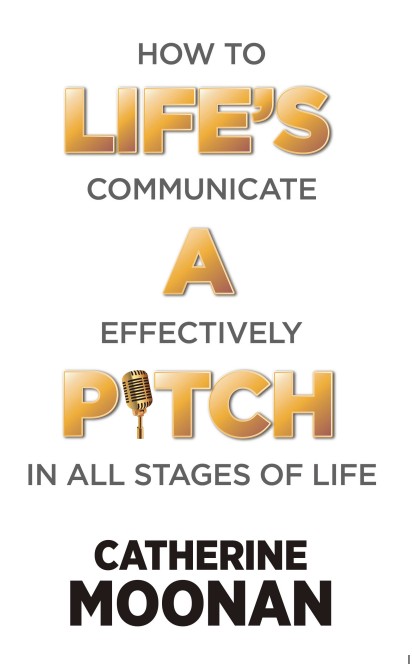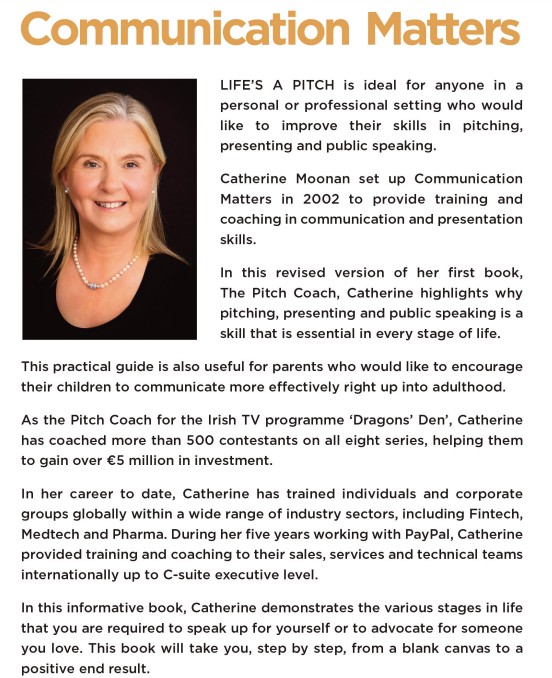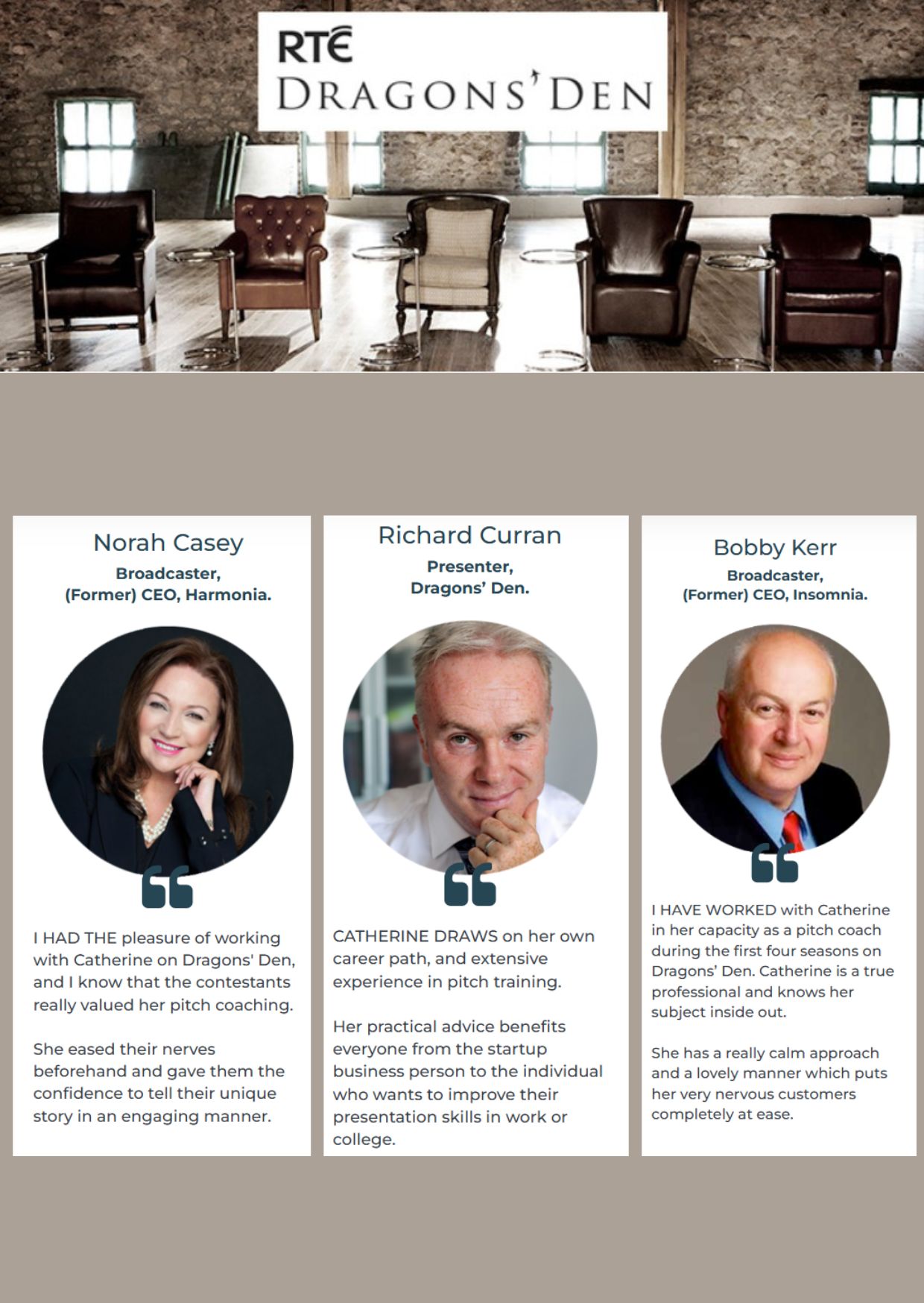
This week on Talk Learn Connect, Journalist Yvonne Reddin asks Catherine Moonan, Pitch Coach & Author, to share some TLC
Why and how did you become a Pitch Coach, where did your influences in this profession stem from?
I founded Communication Matters in 2002 to provide training in communication and presentation skills. Before that, I managed 50 staff at Compaq Computers, taught French and German and worked as Aer Lingus cabin crew. I also had a background in Speech and Drama, so I combined my experience in management, teaching and customer service to help people overcome public speaking fears and improve their communication skills.
I began training in the corporate sector, with my first session for Bank of Scotland (Ireland) at the National Concert Hall—a success that led to work with major companies like Bank of Ireland, AIB, IBM, Intel and Kerry Group. I also trained start-ups through the DIT Hothouse (now New Frontiers) and loved the energy of entrepreneurship. Not everyone is a natural storyteller, so I use a unique blend of mindfulness, music and colour to help people craft authentic, engaging narratives.
In 2008, I graduated with a master’s in journalism from DCU and started writing feature articles for the Irish Independent, Health and Living supplement on a freelance basis. My writing complemented my training even further as it was all storytelling.
"I remember reading an article in the Sunday Business Post that the production company, ShinAwiL was bringing ‘Dragons’ Den’ to RTÉ television. I contacted them and pitched to work as a Presentation Coach, as I called it. I ended up working on all eight seasons of the television programme, coaching over 500 contestants and helping them to gain over €5 million investment."
Over the years, I became known as the ‘Pitch Coach’ by the production team. At the same time, I started to work with other start-up and accelerator programmes in Ireland, the UK, France and Italy. My first book, The Pitch Coach, was published in 2016 where I interviewed lots of start-ups, investors, and people in the corporate world about the importance of pitching, presenting and public speaking.
I joined PayPal in 2018, advancing from Internal Communications Manager to Business Operations Engagement Manager before creating a Sales Trainer role on the Revenue Enablement team. There, I delivered my ‘Life’s A Pitch’ workshop globally, including to C-suite leaders. After leaving in 2023, I joined Enterprise Ireland’s New Frontiers Programme to scale my Pitch Coach brand, and I’m thrilled that my second book, Life’s A Pitch, is now available to complement my workshops.
What are the key elements of a compelling pitch that grabs the person/audience’s attention?
There are three main elements to a pitch: audience, content and delivery.
The audience or listener is the starting point of any pitch. The audience will determine the content of your pitch. You need to research your audience so you can tailor your pitch to your target audience. The main questions to ask yourself while gathering your content are – Why should they care? What’s in it for them? How are they going to benefit from hearing what you have to say? For example, is what you’re offering going to save them money, make them money, save them time, mitigate risk? What’s the emotional connection with this audience? Finally, what do you want this audience to do, think or feel from hearing your pitch?
As regards content, think of your pitch like the trailer of the movie, not the whole movie. You’re not going to be able to use all of your content. Think ‘less is more’. You need to pick and choose the golden nuggets that will engage this target audience and make them want to see the whole movie.
You need to carve out the content you plan to use into a simple, interesting story that your audience will remember.
"Your story or pitch should consist of a WOW opening – something that will hook the attention of your audience. This could be a quote, question, bold fact, figure or statement"
If you don't get the attention of your audience at the start, it will be very hard to get it after 1, 5 or 10 minutes. Research tells us that we have just seven seconds to grab the attention of our audience.
Depending on what you are pitching, try and carve out your content into three umbrella headings with a logical flow where ‘a’ leads to ‘be’ leads to ‘c’. You’re taking the audience, step by step, through your train of thought where there is no room for confusion. Where possible, use short, sharp, punchy sentences or sound bites instead of long-winded sentences where you lose your own train of thought half-way through.
The closing of your pitch needs to overlap back with the opening. For example, if you’ve used a question, quote, bold fact, figure or statement, refer back to it. Include a summary of your main points, a call to action, thank your audience for listening and welcome any questions.
The delivery of the pitch is where a lot of people need help as it plays a huge part in how your message is received. As the saying goes, you never get a second chance to make a first impression. Delivery is made up of body language, tone of voice and the words that you use. You need to come across as confident as possible in order to instil confidence in your audience. Sales leaders like to call it executive presence. Keep your shoulders back and your feet fixed to the ground. Gesture as you would in normal conversation. Gesture reinforces your message. Eye contact is key. The eyes are the window to the soul. People look you in the eye and decide if they like you, if they can trust you, if they want to work with you, buy from you or invest in you.
To keep your audience engaged, vary your pitch, pace, pause, and emphasis. Project your voice clearly, articulating vowels and consonants so you're easily understood. If you speak too softly or too fast, people will switch off.



Explain more about advocacy and that chapter in your new book ‘Life’s a Pitch’ on being an advocate for somebody?
I feel that this is a chapter that will resonate with a lot of people. Many people shy away from speaking up for themselves, however, when it comes to speaking up for someone they love, they really step out of their comfort zone. It’s a natural instinct to want to protect the people we love. I have seen it over the years where friends have advocated for their children in school or sports settings where they felt their child was being bullied or wasn’t being treated fairly. Similarly, you see parents in the news every day of the week speaking out for better healthcare, including less wait times, for their children who are in need of life-saving treatment, not to mention advocating for better care for the increasing number of children/teenagers with mental health difficulties.
Many parents are of the sandwich generation, where they are caring for young children as well as elderly parents (while often working full-time). This can be a huge strain. Elderly parents may eventually need carers in their own home or may need to go into a nursing home. Knowing how to communicate effectively can help to get the right care or the right nursing home for them.
From a personal perspective, I have huge experience being an advocate for my dad while my three daughters were very young and I was running my own business. I found that being able to communicate effectively was a great advantage. In summary, my dad was given four hours to live after all his organs shut down following a major stroke. He lasted four and a half years. He was eight months in hospital and six months in a nursing home. We were told he would never come home. He needed 24-hour care due to vascular dementia, dialysis and limited mobility. I managed to get him home with 24-hour care (part-paid by the state and the other part by my mother).
Dad was very agitated at home and the first nine carers came and left. He was on 35 tablets a day, nine of which were anti-psychotic drugs. I collaborated with a team of doctors and, over a period of three months, managed to wean him off these nine drugs a day (63 a week). In the fourth month, the light bulb came back on in his brain and for the remaining three years of his life, we had my lovely dad back. Advocating on his behalf was hard work but extremely rewarding when we got such a miraculous result.
What common mistakes do people make when pitching, and how can you avoid them? What daily exercises or habits can help improve your overall speaking confidence?
Common mistakes people make are not researching their audience, and therefore, not engaging them with content that interests them. Many people speak for far too long and their audience switches off. Others use language that the audience doesn’t understand, for example, technical jargon that alienates their audience.
Some people have very distracting mannerisms, especially around body language and tone of voice. Prepare in advance. Practice out loud. If possible, use a video during your practice and look back at the recording from an audience perspective. Make the necessary changes. Avoid hands in pockets or clasped to the front or back. Keep your hands by your side. Avoid looking out the window, at the floor or the ceiling – look people in the eye. If it’s a large audience – look at people on your left, right and those in the centre of the room.
Avoid speaking too low – project your voice. Avoid speaking too fast or too slow – vary the pace.
"To improve your speaking confidence, take every opportunity to speak in public. Each time you do it, pat yourself on the back and congratulate yourself for doing it. It’s not easy. Then, ask yourself what could I do better next time?"
A simple exercise you can do is to get out a children’s story book and read it out loud. ‘Goldilocks and the Three Bears’ is a perfect example. Vary the pitch and pace of the voice for each of the three bears and Goldilocks. Use pause and emphasis. Bring this variation of the voice into your pitch. The voice is like a musical instrument and is a great way to engage your audience.
Is there advice you received along your journey, that you still follow in your profession today?
I don’t remember any particular advice, but I had two great role models or mentors who helped me along my journey.
I started Speech and Drama lessons at the age of five with a lovely lady, Peggy O’Regan. Peggy was kind, gentle and encouraging with a beautiful speaking voice. She gave me the confidence and self-belief to perform in speaking competitions and exams right into my early twenties. It was because of Peggy that I had the confidence to set up my own business in the first place, using my talent that she had nurtured in me from a young child. I remained friends with her until she passed away a couple of years ago in her early nineties.
The second person who left a lasting impression on me was a lovely, kind gentleman called Sam Young who I met in my thirties. Sam facilitated workshops on the book ‘The Artist’s Way’ by Julia Cameron and ‘The Power of Now’ by Eckhart Tolle. I attended both workshops and they were transformative. Because of Sam’s workshop on ‘The Artist’s Way’, I went back to university at age 39 and with three young children to do a master’s in journalism. Because of Sam’s workshops on ‘The Power of Now’, I decided to bring a mindful breath meditation into my pitch workshop.
I still use Sam's mindful breath meditation in all my workshops. I also included it in my book 'Life's A Pitch'. It pauses all thinking and parks any preconceptions about what should be in your pitch. Then when you brainstorm using music and colour, you start thinking from the heart as well as the head and you get more authentic content that connects with your target audience.
Contact Catherine at: catherine@pitchcoach.ie
www.pitchcoach.ie
